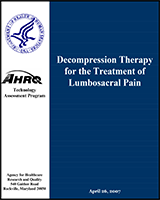NCBI Bookshelf. A service of the National Library of Medicine, National Institutes of Health.
Jurecki-Tiller M, Bruening W, Tregear S, et al. Decompression Therapy for the Treatment of Lumbosacral Pain [Internet]. Rockville (MD): Agency for Healthcare Research and Quality (US); 2007 Apr 26.
This publication is provided for historical reference only and the information may be out of date.
The Centers for Medicare and Medicaid Services (CMS) requested that AHRQ commission an evidence report to assist in updating the CMS policy regarding decompression therapy for chronic low back pain. Accordingly, on January 17, 2006, AHRQ issued a Statement of Work (SOW) contracting ECRI to prepare an evidence-based report on this topic. In commissioning this report, AHRQ, in consultation with CMS and ECRI, developed four key questions. These key questions are as follows:
- What are the patient inclusion and exclusion criteria used in studies of decompression therapy?
- What are the efficacy or effectiveness outcomes measured in studies of decompression therapy? Are the efficacy/effectiveness outcome measured in studies of decompression therapy comparable to those used in studies of other non-surgical modalities for chronic low back pain due to a herniated disc or degenerative disc disease?
- Is decompression therapy an effective treatment for chronic low back pain due to herniated disc or degenerative disc disease?
- Do patients with chronic low back pain (due to herniated disc or degenerative disc disease) who are treated with decompression therapy have more, less, or the same level of pain relief than patients who are treated with other therapies?
- Do patients treated with decompression therapy for chronic low back pain due to a herniated disc or degenerative disc disease utilize more, less, or the same number of adjunctive therapies (e.g., medications, bracing) than patients treated with other therapies?
- Do patients treated with decompression therapy for chronic low back pain due to a herniated disc or degenerative disc disease return to work more quickly than patients treated with other therapies?
- If the therapy is effective, what is the duration of relief achieved?
- If the therapy is effective, what are the patient characteristics/indications of those for whom it appears to work? Is the therapy effective for the Medicare population (over 65 years of age)?
- If it works, which, if any, particular decompression protocol provides the most pain relief?
- What complications, harms, and adverse events associated with decompression therapy have been reported?
- Would the characteristics of the Medicare population (osteoporosis, etc.) increase the likelihood of adverse events compared to the trial populations?
Procedures defined by the U.S. Food and Drug Administration (FDA) as “traction therapy” which are not part of the ITH 510k (‘equipment, powered traction’) product code, are beyond the scope of this report.
- Scope of Report - Decompression Therapy for the Treatment of Lumbosacral PainScope of Report - Decompression Therapy for the Treatment of Lumbosacral Pain
- Erratic myoclonusErratic myoclonusMedGen
- C4476727[conceptid] (1)MedGen
Your browsing activity is empty.
Activity recording is turned off.
See more...
